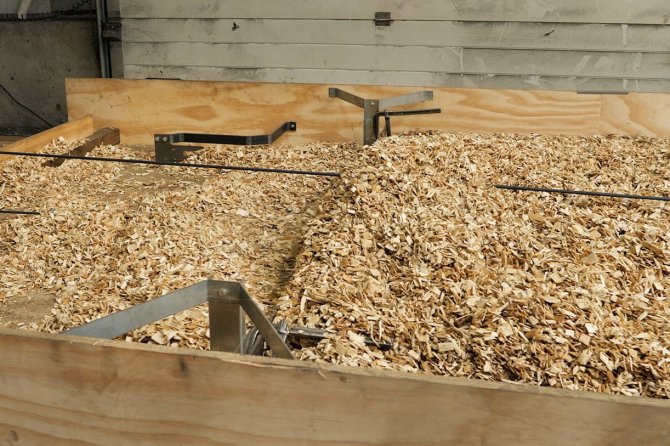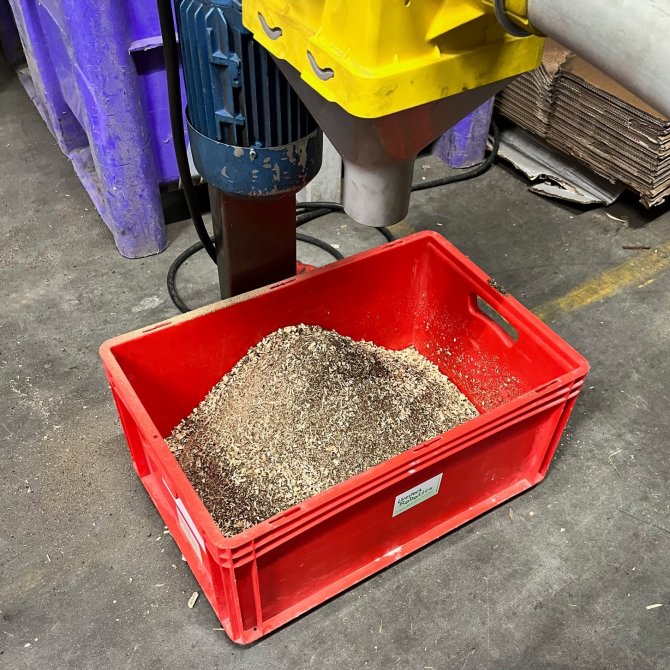The welfare of chickens is often still difficult to reconcile with environmental objectives. Ellen van Weeghel and Bram Bos of Wageningen Livestock Research believe they can solve this. They're working on a new design for a barn in which manure is tidied up as the chickens forage, and a separate area is provided for the birds to take dust baths. "The bathhouse is incredibly popular with the chickens."
The majority of chickens in the Netherlands are provided with a layer of bedding to forage in. However, a lot of manure also ends up in that layer of bedding. This is problematic, because manure left on the ground releases ammonia. Foraging also creates another problem: particulate matter, which is released into the air both inside and outside the barn. Particulate matter is a health hazard for both chickens and humans. Particulate matter emissions need to be reduced significantly by 2030, in line with agreements made between the government and the poultry sector and in accordance with European air quality guidelines.
"Particulate matter is a difficult issue to deal with. This especially goes for laying hens, whose manure stays in the barn for months. This inevitably leads to the release of particulate matter," explains Bram Bos, senior research associate in system innovations for sustainable livestock. "We want chickens to be able to forage, but we don't want particulate matter to be released when they do so. Otherwise, there will always be a trade-off between environmental and welfare objectives," says Ellen van Weeghel, who works on animal-focused design and humane livestock management.
More foraging, less particulate matter
However, Bos and Van Weeghel think there's another way to approach this, based on an innovative plan for happy chickens and a 'clean' environment. They're working in partnership with Smederij Geerts B.V., Livestock Robotics and the Praktijkcentrum Emissiereductie Veehouderij (a research centre for reducing livestock emissions).
The natural behaviour of chickens positively affects the functionality of this entire system
The plan consists of two parts: the manure sieve and the dust bathhouse. The idea behind the sieve is that manure deposited into a thick layer of woodchips will dry out and then disintegrate as the chickens scratch about in it. The small particles of manure then sink between the chips instead of being churned up into the air as particulate matter. Meanwhile, a large, shallow tray moves below the woodchips and catches the manure. The tray acts like a sieve, with a mesh too fine for the rough woodchips to fall through. Only the manure particles fall down into it.
The researchers came up with the idea during a design workshop in which farmers and other businesses also participated. A colleague who worked with Bos and Van Weeghel then started putting something together using materials from the hardware store. "A month later, we had a tray that could collect the manure from the bedding," says Bos. "It was a very makeshift system, with the tray being pulled along by strings under the bedding." A second, larger version was tested with chickens at the MBO Aeres Poultry Innovation Center in Barneveld. The concept worked there, too. A manure sieve measuring 2.5 by 15 metres is now ready for the next round of technical tests. The aim is eventually to apply the system to an entire chicken coop.
Leveraging behaviour
"The manure sieve leverages the natural behaviour of the chickens, so their behaviour plays a positive role in the functioning of the whole system," Van Weeghel explains. That's real progress, because their foraging behaviour previously actually increased emissions. This is because, when fine manure particles become airborne, they don't readily settle back down, and create particulate emissions as a result. Meanwhile, manure on the ground would also be creating more ammonia. "Thanks to this new approach, foraging will now actually improve manure disposal." The heat generated by the chickens also accelerates the disintegration of the manure, and the layer of bedding is so thick that any manure that remains in there is less likely to be kicked up into the air by the foraging chickens.
The trials have already shown how much manure the sieve captures: almost 100 per cent. The actual extent of the reduction of particulate matter by the manure sieve remains to be seen, but Bos is cautiously optimistic. "Manure is the source of about 90 per cent of all the particulate matter in a chicken coop. We also know that this is almost exclusively the result of foraging behaviour. As soon as chickens go to sleep, emissions drop to zero. So, if you capture almost all the manure in the foraging zone, I would expect at least an 80 per cent reduction in particulate matter." The researchers also expect to see a reduction in ammonia levels. Proof of the environmental benefits is expected to emerge out of the next phase of research.
Dust baths
While the layer of coarse woodchip is perfect for foraging, it is actually inconvenient for the expression of other natural chicken behaviour. Chickens enjoy taking a dust bath from time to time, but to do so, they need a fine substance rather than rough woodchips. They find a spot, scrape around with their beak and feet, and then squat and lie down. They then use their wings to cover all their feathers with sand or fine dust. After about twenty minutes, they'll stand up, shake off any excess dust and carry on with other activities. A dust bath helps them deal with dirt, itching and parasites and keeps their feathers in good condition.
- Unfortunately, your cookie settings do not allow videos to be displayed. - check your settings
In the coops they have now, chickens often don't complete their dust bath. "They keep starting over, because the layer of bedding is thin and they're often disturbed," says Van Weeghel. "But chickens really need to take a full dust bath every other day." Conditions were therefore already less than ideal for the chickens' welfare, and the coarse woodchip required by the manure sieve makes it even more difficult to have dust baths.
Combined approach
In 2011, Van Weeghel had already worked with colleagues and others in the industry to design a separate area where chickens could take dust baths to their heart's content: a dust bathhouse. However, it proved difficult to get farmers interested, because it wasn't something they needed. The chickens could just take dust bathsin a thin layer of bedding with manure in it.
With the advent of the manure sieve, however, Bos and Van Weeghel think a bathhouse - part two of their plan - will appeal. That's because dust baths also send dust into the air, and if you have a dust bathhouse, this is all contained in one place. In a barn with a manure sieve and a dust bathhouse, chickens will be able to forage in a rough substrate and bathe in a thick layer of fine substrate. That's a win for farmers, chickens and the local area from an environmental and welfare perspective.
The two researchers therefore revisited their dust bathhouse concept in 2022. They had a new version built with support from the Barth-Misset Fund and placed it in the Kipster c in Beuningen. This trial version measures 3.5 by 1.5 metres. The bathhouse consists of a tray with a thick layer of sand or coconut grit for bathing, and space for the chickens to shake out their feathers before they leave the bathhouse. The actual bathhouse will eventually be larger, and farmers will be able to install it as a standalone unit within the barn, or integrate it into the structure of an existing aviary.
The needs of chicken and farmer meet, as the system should also be viable to the farmer
Popularity of the bathhouse
An initial test showed that the bathhouse was an immediate hit, with throngs of chickens trying to get in. "We have images where you can see how the whole bathhouse is full of chickens," says Van Weeghel. "They're exceptionally keen." One of the next steps is to analyse the images using artificial intelligence. This is expected to provide more detail on how often chickens take dust baths, and how much time they spend on them, for example. "We want a really clear understanding of what chickens like to do, and modify the system accordingly. Meanwhile, we'll also be taking health and environmental considerations on board. For example, we have to prevent the dust escaping. That's why it's a separate, contained structure."

The next step is to prepare the manure sieve and dust bathhouse for a one-year experiment at a poultry farm. This experiment will consider the needs of both farmers and chickens, because the system needs to work for farmers too. As part of the experiment, researchers will scrutinise the behaviour of the chickens, monitor their health, and measure the levels of particulate matter and ammonia.

Dignified lives for animals
Van Weeghel and Bos would eventually like all chickens to be housed in barns with separate areas for sleeping, dust bathing and foraging. Such facilities would help the animals live more dignified lives, which is a policy objective of Mark Rutte's fourth (now demissionary) cabinet, based on the recommendation of the Council on Animal Affairs and inspired by a proposal from the political party Partij voor de Dieren (Party for the Animals).
Meanwhile, Van Weeghel is already thinking about the further development of the manure sieve. "For example, if you put a tray on it that left behind edible things under the substrate for the chickens, they'd really have something to forage for under the bedding. That's the whole point of the behaviour, of course. The chickens don't merely want to search - they want to actually find something good to eat too."






